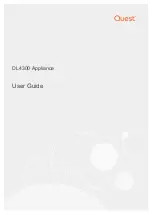
DL4300 Appliance
Snapshot process
15
Parent topic
Smart Agent
Smart Agent tracks the changed blocks on the disk volume and then snaps an image of the changed blocks at
a predefined interval of protection. The incremental forever block-level snapshots approach prevents repeated
copying of the same data from the protected machine to the Core. The Rapid Recovery Smart Agent is installed
on the machines that are protected by the Rapid Recovery Core.
The Smart Agent is application-aware and it detects the type of application that is installed and also the location of
the data. It automatically groups data volumes with dependency, such as databases, and then logs them together
for effective protection and rapid recovery. After the Rapid Recovery Agent software is configured, it uses smart
technology to keep track of changed blocks on the protected disk volumes. When the snapshot is ready, it is
rapidly transferred to the Core using intelligent multi-threaded, socket-based connections. To preserve CPU
bandwidth and memory on the protected machines, the smart agent does not encrypt or deduplicate the data at
the source and protected machines are paired with a Core for protection.
Parent topic
DL Appliance Core
The Core is the central component of the deployment architecture. The Core stores and manages all of the
machine backups and provides core services for backup, recovery, and retention; replication, archival, and
management. The Core is a self-contained network-addressable computer that runs a 64-bit of Microsoft
Windows operating system. Your appliance performs target-based inline compression, encryption, and
deduplication of the data received from the protected machine. The Core then stores the snapshot backups in
repositories such as, Storage Area Network (SAN) or Direct Attached Storage (DAS).
The repository can also reside on internal storage within the Core. The Core is managed by accessing the
following URL from a Web browser: https://CORENAME:8006/apprecovery/admin. Internally, all core services
are accessible through REST APIs. The Core services can be accessed from within the core or directly over the
Internet from any application that can send an HTTP/HTTPS request and receive an HTTP/HTTPS response. All
API operations are performed over SSL and mutually authenticated using X.509 v3 certificates.
Cores are paired with other cores for replication.
Parent topic
Snapshot process
A snapshot is when a base image is transferred from a protected machine to the Core. Snapshots capture and
store the state of a disk volume at a given point in time while the applications that generate the data are still
in use. In Rapid Recovery, you can force a snapshot, temporarily pause snapshots, and view lists of current
recovery points in the repository as well as delete them if needed. Recovery points are used to restore protected
machines or to mount to a local file system. The snapshots that are captured by Rapid Recovery are done so at
the block level and are application aware. This means that all open transactions and rolling transaction logs are
completed and caches are flushed to disk before creating the snapshot.
Rapid Recovery uses a low-level volume filter driver, which attaches to the mounted volumes and then tracks
all block-level changes for the next impending snapshot. Microsoft Volume Shadow Services (VSS) is used to
facilitate application crash consistent snapshots.
Parent topic
















































